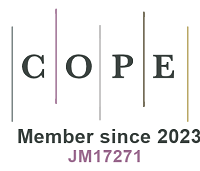REFERENCES
1. Stefanakis AI, Becker JA. A review of emerging contaminants in water. In: Mckeown AE, Bugyi G, editors. Impact of Water Pollution on Human Health and Environmental Sustainability. IGI Global; 2016. pp. 55-80.
2. Ajima MN, Ogo OA, Audu BS, Ugwoegbu KC. Chronic diclofenac (DCF) exposure alters both enzymatic and haematological profile of African catfish, Clarias gariepinus. Drug Chem Toxicol 2015;38:383-90.
3. Fekadu S, Alemayehu E, Dewil R, Van der Bruggen B. Pharmaceuticals in freshwater aquatic environments: a comparison of the African and European challenge. Sci Total Environ 2019;654:324-37.
4. Hanif H, Waseem A, Kali S, et al. Environmental risk assessment of diclofenac residues in surface waters and wastewater: a hidden global threat to aquatic ecosystem. Environ Monit Assess 2020;192:204.
5. Melvin SD. Oxidative stress, energy storage, and swimming performance of Limnodynastes peronii tadpoles exposed to a sub-lethal pharmaceutical mixture throughout development. Chemosphere 2016;150:790-7.
6. Gómez-Oliván LM, Galar-Martínez M, García-Medina S, Valdés-Alanís A, Islas-Flores H, Neri-Cruz N. Genotoxic response and oxidative stress induced by diclofenac, ibuprofen and naproxen in Daphnia magna. Drug Chem Toxicol 2014;37:391-9.
7. Gan TJ. Diclofenac: an update on its mechanism of action and safety profile. Curr Med Res Opin 2010;26:1715-31.
8. Ulubay M, Yurt KK, Kaplan AA, Atilla MK. The use of diclofenac sodium in urological practice: a structural and neurochemical based review. J Chem Neuroanat 2018;87:32-6.
9. Altman R, Bosch B, Brune K, Patrignani P, Young C. Advances in NSAID development: evolution of diclofenac products using pharmaceutical technology. Drugs 2015;75:859-77.
10. Bickley LK, van Aerle R, Brown AR, et al. Bioavailability and kidney responses to diclofenac in the fathead minnow (pimephales promelas). Environ Sci Technol 2017;51:1764-74.
11. Cunha SC, Pena A, Fernandes JO. Mussels as bioindicators of diclofenac contamination in coastal environments. Environ Pollut 2017;225:354-60.
12. Bonnefille B, Gomez E, Courant F, Escande A, Fenet H. Diclofenac in the marine environment: a review of its occurrence and effects. Mar Pollut Bull 2018;131:496-506.
13. Sathishkumar P, Meena RAA, Palanisami T, Ashokkumar V, Palvannan T, Gu FL. Occurrence, interactive effects and ecological risk of diclofenac in environmental compartments and biota - a review. Sci Total Environ 2020;698:134057.
14. Lonappan L, Brar SK, Das RK, Verma M, Surampalli RY. Diclofenac and its transformation products: Environmental occurrence and toxicity - a review. Environ Int 2016;96:127-38.
15. Bio S, Nunes B. Acute effects of diclofenac on zebrafish: Indications of oxidative effects and damages at environmentally realistic levels of exposure. Environ Toxicol Pharmacol 2020;78:103394.
16. Yang YY, Zhao JL, Liu YS, et al. Pharmaceuticals and personal care products (PPCPs) and artificial sweeteners (ASs) in surface and ground waters and their application as indication of wastewater contamination. Sci Total Environ 2018;616-617:816-23.
17. Kermia AEB, Fouial-djebbar D, Trari M. Occurrence, fate and removal efficiencies of pharmaceuticals in wastewater treatment plants (WWTPs) discharging in the coastal environment of Algiers. Comptes Rendus Chimie 2016;19:963-70.
18. Sousa DNR, Mozeto AA, Carneiro RL, Fadini PS. Spatio-temporal evaluation of emerging contaminants and their partitioning along a Brazilian watershed. Environ Sci Pollut Res Int 2018;25:4607-20.
19. Branchet P, Ariza Castro N, Fenet H, et al. Anthropic impacts on Sub-Saharan urban water resources through their pharmaceutical contamination (Yaoundé, Center Region, Cameroon). Sci Total Environ 2019;660:886-98.
20. Gumbi BP, Moodley B, Birungi G, Ndungu PG. Detection and quantification of acidic drug residues in South African surface water using gas chromatography-mass spectrometry. Chemosphere 2017;168:1042-50.
21. González-Alonso S, Merino LM, Esteban S, et al. Occurrence of pharmaceutical, recreational and psychotropic drug residues in surface water on the northern Antarctic Peninsula region. Environ Pollut 2017;229:241-54.
22. Sharma BM, Bečanová J, Scheringer M, et al. Health and ecological risk assessment of emerging contaminants (pharmaceuticals, personal care products, and artificial sweeteners) in surface and groundwater (drinking water) in the Ganges River Basin, India. Sci Total Environ 2019;646:1459-67.
23. Jindal K, Narayanam M, Singh S. A systematic strategy for the identification and determination of pharmaceuticals in environment using advanced LC-MS tools: application to ground water samples. J Pharm Biomed Anal 2015;108:86-96.
24. Kapelewska J, Kotowska U, Karpińska J, Kowalczuk D, Arciszewska A, Świrydo A. Occurrence, removal, mass loading and environmental risk assessment of emerging organic contaminants in leachates, groundwaters and wastewaters. Microchem J 2018;137:292-301.
25. Rodil R, Quintana JB, Concha-Graña E, López-Mahía P, Muniategui-Lorenzo S, Prada-Rodríguez D. Emerging pollutants in sewage, surface and drinking water in Galicia (NW Spain). Chemosphere 2012;86:1040-9.
26. Tröger R, Klöckner P, Ahrens L, Wiberg K. Micropollutants in drinking water from source to tap - method development and application of a multiresidue screening method. Sci Total Environ 2018;627:1404-32.
27. Simazaki D, Kubota R, Suzuki T, Akiba M, Nishimura T, Kunikane S. Occurrence of selected pharmaceuticals at drinking water purification plants in Japan and implications for human health. Water Res 2015;76:187-200.
28. Carmona E, Andreu V, Picó Y. Occurrence of acidic pharmaceuticals and personal care products in Turia River Basin: from waste to drinking water. Sci Total Environ 2014;484:53-63.
29. Brumovský M, Bečanová J, Kohoutek J, Borghini M, Nizzetto L. Contaminants of emerging concern in the open sea waters of the Western Mediterranean. Environ Pollut 2017;229:976-83.
30. Kallenborn R, Brorström-Lundén E, Reiersen LO, Wilson S. Pharmaceuticals and personal care products (PPCPs) in Arctic environments: indicator contaminants for assessing local and remote anthropogenic sources in a pristine ecosystem in change. Environ Sci Pollut Res Int 2018;25:33001-13.
31. Bayen S, Zhang H, Desai MM, Ooi SK, Kelly BC. Occurrence and distribution of pharmaceutically active and endocrine disrupting compounds in Singapore’s marine environment: influence of hydrodynamics and physical-chemical properties. Environ Pollut 2013;182:1-8.
32. Chernova E, Zhakovskaya Z, Berezina N. Occurrence of pharmaceuticals in the Eastern Gulf of Finland (Russia). Environ Sci Pollut Res Int 2021;28:68871-84.
33. Ali AM, Rønning HT, Alarif W, Kallenborn R, Al-Lihaibi SS. Occurrence of pharmaceuticals and personal care products in effluent-dominated Saudi Arabian coastal waters of the Red Sea. Chemosphere 2017;175:505-13.
34. Biel-Maeso M, Baena-Nogueras RM, Corada-Fernández C, Lara-Martín PA. Occurrence, distribution and environmental risk of pharmaceutically active compounds (PhACs) in coastal and ocean waters from the Gulf of Cadiz (SW Spain). Sci Total Environ 2018;612:649-59.
35. Liu HQ, Lam JCW, Li WW, Yu HQ, Lam PKS. Spatial distribution and removal performance of pharmaceuticals in municipal wastewater treatment plants in China. Sci Total Environ 2017;586:1162-9.
36. Lindholm-Lehto PC, Ahkola HS, Knuutinen JS, Herve SH. Widespread occurrence and seasonal variation of pharmaceuticals in surface waters and municipal wastewater treatment plants in central Finland. Environ Sci Pollut Res Int 2016;23:7985-97.
37. Wilkinson JL, Swinden J, Hooda PS, Barker J, Barton S. Markers of anthropogenic contamination: a validated method for quantification of pharmaceuticals, illicit drug metabolites, perfluorinated compounds, and plasticisers in sewage treatment effluent and rain runoff. Chemosphere 2016;159:638-46.
38. Česen M, Ahel M, Terzić S, Heath DJ, Heath E. The occurrence of contaminants of emerging concern in Slovenian and Croatian wastewaters and receiving Sava river. Sci Total Environ 2019;650:2446-53.
39. Chiffre A, Degiorgi F, Buleté A, Spinner L, Badot PM. Occurrence of pharmaceuticals in WWTP effluents and their impact in a karstic rural catchment of Eastern France. Environ Sci Pollut Res Int 2016;23:25427-41.
40. Christou A, Karaolia P, Hapeshi E, Michael C, Fatta-Kassinos D. Long-term wastewater irrigation of vegetables in real agricultural systems: concentration of pharmaceuticals in soil, uptake and bioaccumulation in tomato fruits and human health risk assessment. Water Res 2017;109:24-34.
41. Corada-Fernández C, Jiménez-Martínez J, Candela L, González-Mazo E, Lara-Martín PA. Occurrence and spatial distribution of emerging contaminants in the unsaturated zone. case study: Guadalete River basin (Cadiz, Spain). Chemosphere 2015;119 Suppl:S131-7.
42. Ashfaq M, Nawaz Khan K, Saif Ur Rehman M, et al. Ecological risk assessment of pharmaceuticals in the receiving environment of pharmaceutical wastewater in Pakistan. Ecotoxicol Environ Saf 2017;136:31-9.
43. Grossberger A, Hadar Y, Borch T, Chefetz B. Biodegradability of pharmaceutical compounds in agricultural soils irrigated with treated wastewater. Environ Pollut 2014;185:168-77.
44. Čelić M, Gros M, Farré M, Barceló D, Petrović M. Pharmaceuticals as chemical markers of wastewater contamination in the vulnerable area of the Ebro Delta (Spain). Sci Total Environ 2019;652:952-63.
45. Peng FJ, Pan CG, Zhang M, et al. Occurrence and ecological risk assessment of emerging organic chemicals in urban rivers: Guangzhou as a case study in China. Sci Total Environ 2017;589:46-55.
46. Omar TFT, Aris AZ, Yusoff FM, Mustafa S. Occurrence, distribution, and sources of emerging organic contaminants in tropical coastal sediments of anthropogenically impacted Klang River estuary, Malaysia. Mar Pollut Bull 2018;131:284-93.
47. Wilkinson JL, Hooda PS, Swinden J, Barker J, Barton S. Spatial distribution of organic contaminants in three rivers of Southern England bound to suspended particulate material and dissolved in water. Sci Total Environ 2017;593-594:487-97.
48. Yan Q, Gao X, Chen YP, et al. Occurrence, fate and ecotoxicological assessment of pharmaceutically active compounds in wastewater and sludge from wastewater treatment plants in Chongqing, the Three Gorges Reservoir Area. Sci Total Environ 2014;470-471:618-30.
49. Xue W, Wu C, Xiao K, et al. Elimination and fate of selected micro-organic pollutants in a full-scale anaerobic/anoxic/aerobic process combined with membrane bioreactor for municipal wastewater reclamation. Water Res 2010;44:5999-6010.
50. Stasinakis AS, Thomaidis NS, Arvaniti OS, et al. Contribution of primary and secondary treatment on the removal of benzothiazoles, benzotriazoles, endocrine disruptors, pharmaceuticals and perfluorinated compounds in a sewage treatment plant. Sci Total Environ 2013;463-464:1067-75.
51. Martín J, Santos JL, Aparicio I, Alonso E. Pharmaceutically active compounds in sludge stabilization treatments: anaerobic and aerobic digestion, wastewater stabilization ponds and composting. Sci Total Environ 2015;503-504:97-104.
52. Rodríguez-Navas C, Björklund E, Bak SA, et al. Pollution pathways of pharmaceutical residues in the aquatic environment on the island of Mallorca, Spain. Arch Environ Contam Toxicol 2013;65:56-66.
53. Lu MC, Chen YY, Chiou MR, Chen MY, Fan HJ. Occurrence and treatment efficiency of pharmaceuticals in landfill leachates. Waste Manag 2016;55:257-64.
54. Oliveira LL, Antunes SC, Gonçalves F, Rocha O, Nunes B. Evaluation of ecotoxicological effects of drugs on Daphnia magna using different enzymatic biomarkers. Ecotoxicol Environ Saf 2015;119:123-31.
55. Praskova E, Plhalova L, Chromcova L, et al. Effects of subchronic exposure of diclofenac on growth, histopathological changes, and oxidative stress in zebrafish (Danio rerio). Sci World J 2014;2014:645737.
56. Peltzer PM, Lajmanovich RC, Martinuzzi C, Attademo AM, Curi LM, Sandoval MT. Biotoxicity of diclofenac on two larval amphibians: assessment of development, growth, cardiac function and rhythm, behavior and antioxidant system. Sci Total Environ 2019;683:624-37.
57. Memmert U, Peither A, Burri R, et al. Diclofenac: New data on chronic toxicity and bioconcentration in fish. Environ Toxicol Chem 2013;32:442-52.
58. Nava-álvarez R, Razo-estrada AC, García-medina S, Gómez-olivan LM, Galar-martínez M. Oxidative stress induced by mixture of diclofenac and acetaminophen on common carp (Cyprinus carpio). Water Air Soil Pollut 2014:225.
59. Saucedo-Vence K, Dublán-García O, López-Martínez LX, et al. Short and long-term exposure to diclofenac alter oxidative stress status in common carp Cyprinus carpio. Ecotoxicology 2015;24:527-39.
60. Almeida Â, Solé M, Soares AMVM, Freitas R. Anti-inflammatory drugs in the marine environment: bioconcentration, metabolism and sub-lethal effects in marine bivalves. Environ Pollut 2020;263:114442.
61. Cardoso-Vera JD, Islas-Flores H, SanJuan-Reyes N, et al. Comparative study of diclofenac-induced embryotoxicity and teratogenesis in Xenopus laevis and Lithobates catesbeianus, using the frog embryo teratogenesis assay: Xenopus (FETAX). Sci Total Environ 2017;574:467-75.
62. Islas-Flores H, Gómez-Oliván LM, Galar-Martínez M, Colín-Cruz A, Neri-Cruz N, García-Medina S. Diclofenac-induced oxidative stress in brain, liver, gill and blood of common carp (Cyprinus carpio). Ecotoxicol Environ Saf 2013;92:32-8.
63. Qureshi MA, Ali RA. Spirulina platensis exposure enhances macrophage phagocytic function in cats. Immunopharmacol Immunotoxicol 1996;18:457-63.
64. Hayashi O, Katoh T, Okuwaki Y. Enhancement of antibody production in mice by dietary Spirulina platensis. J Nutr Sci Vitaminol 1994;40:431-41.
65. Khan M, Shobha JC, Mohan IK, Rao Naidu MU, Prayag A, Kutala VK. Spirulina attenuates cyclosporine-induced nephrotoxicity in rats. J Appl Toxicol 2006;26:444-51.
66. Karadeniz A, Cemek M, Simsek N. The effects of Panax ginseng and Spirulina platensis on hepatotoxicity induced by cadmium in rats. Ecotoxicol Environ Saf 2009;72:231-5.
67. Kulshreshtha A, Zacharia AJ, Jarouliya U, Bhadauriya P, Prasad GB, Bisen PS. Spirulina in health care management. Curr Pharm Biotechnol 2008;9:400-5.
68. Parikh P, Mani U, Iyer U. Role of spirulina in the control of glycemia and lipidemia in type 2 diabetes mellitus. J Med Food 2001;4:193-9.
69. Sharma MK, Sharma A, Kumar A, Kumar M. Evaluation of protective efficacy of Spirulina fusiformis against mercury induced nephrotoxicity in Swiss albino mice. Food Chem Toxicol 2007;45:879-87.
70. Rojas-Franco P, Franco-Colín M, Blas-Valdivia V, Melendez-Camargo ME, Cano-Europa E. Arthrospira maxima (Spirulina) prevents endoplasmic reticulum stress in the kidney through its C-phycocyanin. J Zhejiang Univ Sci B 2021;22:603-8.
71. Al-Qahtani WH, Binobead MA. Anti-inflammatory, antioxidant and antihepatotoxic effects of Spirulina platensis against d-galactosamine induced hepatotoxicity in rats. Saudi J Biol Sci 2019;26:647-52.
72. Lu J, Ren DF, Wang JZ, Sanada H, Egashira Y. Protection by dietary Spirulina platensis against D-galactosamine--and acetaminophen-induced liver injuries. Br J Nutr 2010;103:1573-6.
73. James R, Sampath K, Nagarajan R, Vellaisamy P, Manikandan MM. Effect of dietary Spirulina on reduction of copper toxicity and improvement of growth, blood parameters and phosphatases activities in carp, Cirrhinus mrigala (Hamilton, 1822). Indian J Exp Biol 2009;47:754-9.
74. Gad AS, Khadrawy YA, El-Nekeety AA, Mohamed SR, Hassan NS, Abdel-Wahhab MA. Antioxidant activity and hepatoprotective effects of whey protein and Spirulina in rats. Nutrition 2011;27:582-9.
75. Zhang Y, Zhou Y, Tang Q, et al. The protective effects of selenium-enriched spirulina on the reproductive system of male zebrafish (Danio rerio) exposed to beta-cypermethrin. Food Funct 2018;9:5791-804.
76. Tenorio-Chávez P, Elizalde-Velázquez GA, Gómez-Oliván LM, Hernández-Navarro MD. Chronic intake of an enriched diet with spirulina (Arthrospira maxima) alleviates the embryotoxic effects produced by realistic concentrations of tetracycline in Danio rerio. Sci Total Environ 2023;859:159731.
77. Kim MY, Cheong SH, Lee JH, Kim MJ, Sok DE, Kim MR. Spirulina improves antioxidant status by reducing oxidative stress in rabbits fed a high-cholesterol diet. J Med Food 2010;13:420-6.
78. Afkhami-Ardakani M, Hasanzadeh S, Shahrooz R, Delirezh N, Malekinejad H. Antioxidant effects of Spirulina platensis (Arthrospira platensis) on cyclophosphamide-induced testicular injury in rats. Vet Res Forum 2018;9:35-41.
79. Muga MA, Chao JC. Effects of fish oil and spirulina on oxidative stress and inflammation in hypercholesterolemic hamsters. BMC Complement Altern Med 2014;14:470.
80. Toughan H, Khalil SR, El-Ghoneimy AA, Awad A, Seddek AS. Effect of dietary supplementation with Spirulina platensis on Atrazine-induced oxidative stress- mediated hepatic damage and inflammation in the common carp (Cyprinus carpio L.). Ecotoxicol Environ Saf 2018;149:135-42.
81. Abdelkhalek NKM, Eissa IAM, Ahmed E, et al. Protective role of dietary Spirulina platensis against diazinon-induced Oxidative damage in Nile tilapia; Oreochromis niloticus. Environ Toxicol Pharmacol 2017;54:99-104.
82. Ael-D, Elbaghdady HA, Zahran E. Arsenic-induced genotoxicity in Nile tilapia (Orechromis niloticus); the role of Spirulina platensis extract. Environ Monit Assess 2015;187:751.
83. Rajasekar P, Palanisamy S, Anjali R, et al. Isolation and structural characterization of sulfated polysaccharide from Spirulina platensis and its bioactive potential: In vitro antioxidant, antibacterial activity and Zebrafish growth and reproductive performance. Int J Biol Macromol 2019;141:809-21.
84. American Society for Testing Materials. Standard guide for conducting the frog embryo teratogenesis assay - Xenopus (FETAX). Available from: https://www.astm.org/e1439-12r19.html [Last accessed on 29 Mar 2023].
85. Chae JP, Park MS, Hwang YS, et al. Evaluation of developmental toxicity and teratogenicity of diclofenac using Xenopus embryos. Chemosphere 2015;120:52-8.
86. Pérez-Alvarez I, Islas-Flores H, Gómez-Oliván LM, Sánchez-Aceves LM, Chamorro-Cevallos G. Protective effects of Spirulina (Arthrospira maxima) against toxicity induced by cadmium in Xenopus laevis. Comp Biochem Physiol C Toxicol Pharmacol 2021;248:109099.
87. Bantle JA, Dumont JN, Finch RA, Linder G. Atlas of abnormalities: a guide for the performance of FETAX. Stillwater, Okla: Printing Services, Oklahoma State University; 1991.
88. Ishibashi S, Amaya E. How to grow Xenopus Laevis tadpole stages to adult. Cold Spring Harb Protoc 2021;2021:pdb.prot106245.
89. Nieuwkoop PD. Normal table of Xenopus laevis (Daudin). A systematical and Chronological Survey of the Development from the Fertilized egg till the end of Metamorphosis, 1st ed. New York: Garland Publishing Inc; 1994.
90. Bradford MM. A rapid and sensitive method for the quantitation of microgram quantities of protein utilizing the principle of protein-dye binding. Anal Biochem 1976;72:248-54.
92. Misra HP, Fridovich I. The role of superoxide anion in the autoxidation of epinephrine and a simple assay for superoxide dismutase. J Biol Chem 1972;247:3170-5.
93. Radi R, Turrens JF, Chang LY, Bush KM, Crapo JD, Freeman BA. Detection of catalase in rat heart mitochondria. J Biol Chem 1991;266:22028-34.
94. Miarov O, Tal A, Avisar D. A critical evaluation of comparative regulatory strategies for monitoring pharmaceuticals in recycled wastewater. J Environ Manage 2020;254:109794.
95. Tixier C, Singer HP, Oellers S, Müller SR. Occurrence and fate of carbamazepine, clofibric acid, diclofenac, ibuprofen, ketoprofen, and naproxen in surface waters. Environ Sci Technol 2003;37:1061-8.
96. Petrie B, Barden R, Kasprzyk-Hordern B. A review on emerging contaminants in wastewaters and the environment: current knowledge, understudied areas and recommendations for future monitoring. Water Res 2015;72:3-27.
97. Bernadac Villegas LG, Puente-Tavares M, Carrillo-Méndez JD, et al. Identificación y cuantificación de diclofenaco en aguas residuales de Ciudad Juárez. Available from: https://revista.itson.edu.mx/index.php/rlrn/article/view/281/214 [Last accessed on 29 Mar 2023].
98. Stepanova S, Praskova E, Chromcova L, et al. The effects of diclofenac on early life stages of common carp (Cyprinus carpio). Environ Toxicol Pharmacol 2013;35:454-60.
99. Penha LCC, Rola RC, Martinez CBDR, Martins CMG. Effects of anti-inflammatory diclofenac assessed by toxicity tests and biomarkers in adults and larvae of Danio rerio. Comp Biochem Physiol C Toxicol Pharmacol 2021;242:108955.
100. Ajima MNO, Kumar K, Poojary N, Pandey PK. Oxidative stress biomarkers, biochemical responses and Na+-K+-ATPase activities in Nile tilapia, Oreochromis niloticus exposed to diclofenac. Comp Biochem Physiol C Toxicol Pharmacol 2021;240:108934.
101. Jung SH, Lee W, Park SH, et al. Diclofenac impairs autophagic flux via oxidative stress and lysosomal dysfunction: implications for hepatotoxicity. Redox Biol 2020;37:101751.
102. Syed M, Skonberg C, Hansen SH. Mitochondrial toxicity of diclofenac and its metabolites via inhibition of oxidative phosphorylation (ATP synthesis) in rat liver mitochondria: possible role in drug induced liver injury (DILI). Toxicol In Vitro 2016;31:93-102.
103. Mirzaee SA, Noorimotlagh Z, Ahmadi M, et al. The possible oxidative stress and DNA damage induced in Diclofenac-exposed non-target organisms in the aquatic environment: a systematic review. Ecol Indic 2021;131:108172.
104. Ghosh R, Goswami SK, Feitoza LFBB, Hammock B, Gomes AV. Diclofenac induces proteasome and mitochondrial dysfunction in murine cardiomyocytes and hearts. Int J Cardiol 2016;223:923-35.
105. Ramachandran A, Visschers RGJ, Duan L, Akakpo JY, Jaeschke H. Mitochondrial dysfunction as a mechanism of drug-induced hepatotoxicity: current understanding and future perspectives. J Clin Transl Res 2018;4:75-100.
106. Soni RA, Sudhakar K, Rana R. Spirulina – From growth to nutritional product: a review. Trends in Food Science & Technology 2017;69:157-71.
107. Wu Q, Liu L, Miron A, Klímová B, Wan D, Kuča K. The antioxidant, immunomodulatory, and anti-inflammatory activities of Spirulina: an overview. Arch Toxicol 2016;90:1817-40.
108. Abu-Taweel GM, Mohsen G AM, Antonisamy P, et al. Spirulina consumption effectively reduces anti-inflammatory and pain related infectious diseases. J Infect Public Health 2019;12:777-82.
109. Khafaga AF, El-Sayed YS. Spirulina ameliorates methotrexate hepatotoxicity via antioxidant, immune stimulation, and proinflammatory cytokines and apoptotic proteins modulation. Life Sci 2018;196:9-17.
110. Kumar P, Desai N, Dwivedi M, Dwivedi M. Multiple potential roles of Spirulina in human health: a critical review. Available from: https://nutriweb.org.my/mjn/publication/21-3/j.pdf [Last accessed on 29 Mar 2023].
111. Liang Y, Bao Y, Gao X, et al. Effects of spirulina supplementation on lipid metabolism disorder, oxidative stress caused by high-energy dietary in Hu sheep. Meat Sci 2020;164:108094.
112. Pestana JM, Puerta B, Santos H, et al. Impact of dietary incorporation of Spirulina (Arthrospira platensis) and exogenous enzymes on broiler performance, carcass traits, and meat quality. Poult Sci 2020;99:2519-32.
113. Slaby S, Hanotel J, Marchand G, et al. Maturation of Xenopus laevis oocytes under cadmium and lead exposures: cell biology investigations. Aquat Toxicol 2017;193:105-10.
114. Aladaileh SH, Khafaga AF, Abd El-Hack ME, et al. Spirulina platensis ameliorates the sub chronic toxicities of lead in rabbits via anti-oxidative, anti- inflammatory, and immune stimulatory properties. Sci Total Environ 2020;701:134879.
115. Nasirian F, Dadkhah M, Moradi-Kor N, Obeidavi Z. Effects of Spirulina platensis microalgae on antioxidant and anti-inflammatory factors in diabetic rats. Diabetes Metab Syndr Obes 2018;11:375-80.
116. Banji D, Banji OJ, Pratusha NG, Annamalai AR. Investigation on the role of Spirulina platensis in ameliorating behavioural changes, thyroid dysfunction and oxidative stress in offspring of pregnant rats exposed to fluoride. Food Chem 2013;140:321-31.
117. Khalil SR, Reda RM, Awad A. Efficacy of Spirulina platensis diet supplements on disease resistance and immune-related gene expression in Cyprinus carpio L. exposed to herbicide atrazine. Fish Shellfish Immunol 2017;67:119-28.
118. Hedayatirad M, Mirvaghefi A, Nematollahi MA, Forsatkar MN, Brown C. Transgenerational disrupting impacts of atrazine in zebrafish: Beneficial effects of dietary spirulina. Comp Biochem Physiol C Toxicol Pharmacol 2020;230:108685.
119. Abdelkhalek NKM, Eissa IAM, Ahmed E, et al. Protective role of dietary Spirulina platensis against diazinon-induced Oxidative damage in Nile tilapia; Oreochromis niloticus. Environ Toxicol Pharmacol 2017;54:99-104.
120. Bashandy SAE, El Awdan SA, Ebaid H, Alhazza IM. Antioxidant potential of Spirulina platensis mitigates oxidative stress and reprotoxicity induced by sodium arsenite in male rats. Oxid Med Cell Longev 2016:2016.
121. El-Tantawy WH. Antioxidant effects of Spirulina supplement against lead acetate-induced hepatic injury in rats. J Tradit Complement Med 2016;6:327-31.
122. Argüelles-Velázquez N, Alvarez-González I, Madrigal-Bujaidar E, Chamorro-Cevallos G. Amelioration of cadmium-produced teratogenicity and genotoxicity in mice given arthrospira maxima (Spirulina) treatment. Evid Based Complement Alternat Med 2013;2013:604535.
123. Peter SJ, Basha SK, Giridharan R, Lavinya BU, Sabina EP. Suppressive effect of Spirulina fusiformis on diclofenac-induced hepato-renal injury and gastrointestinal ulcer in Wistar albino rats: a biochemical and histological approach. Biomed Pharmacother 2017;88:11-8.
124. Park WS, Kim HJ, Li M, et al. Two classes of pigments, carotenoids and C-phycocyanin, in Spirulina powder and their antioxidant activities. Molecules 2018;23:2065.
125. Bhat VB, Madyastha KM. C-phycocyanin: a potent peroxyl radical scavenger in vivo and in vitro. Biochem Biophys Res Commun 2000;275:20-5.
126. Ch, González R, Ledón N, Remirez D, Rimbau V. C-phycocyanin: a biliprotein with antioxidant, anti-inflammatory and neuroprotective effects. Curr Protein Pept Sci 2003;4:207-16.
127. Deng R, Chow TJ. Hypolipidemic, antioxidant, and antiinflammatory activities of microalgae Spirulina. Cardiovasc Ther 2010;28:e33-45.
128. Schafer FQ, Wang HP, Kelley EE, Cueno KL, Martin SM, Buettner GR. Comparing beta-carotene, vitamin E and nitric oxide as membrane antioxidants. Biol Chem 2002;383:671-81.
129. Miyazawa T, Burdeos GC, Itaya M, Nakagawa K, Miyazawa T. Vitamin E: regulatory redox interactions. IUBMB Life 2019;71:430-41.
130. Moradi A, Ziamajidi N, Ghafourikhosroshahi A, Abbasalipourkabir R. Effects of vitamin A and vitamin E on attenuation of titanium dioxide nanoparticles-induced toxicity in the liver of male Wistar rats. Mol Biol Rep 2019;46:2919-32.
131. Choi SW, Benzie IF, Collins AR, Hannigan BM, Strain JJ. Vitamins C and E: acute interactive effects on biomarkers of antioxidant defence and oxidative stress. Mutat Res 2004;551:109-17.







